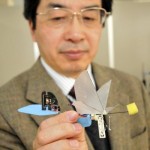In a previous post from the last quarter, Grace Ingalls talked about the physics of how hummingbirds fly. The hummingbird was described to fly more like an insect rather than a bird since it was able to hover in every direction as opposed to conventional birds who flew only in a forward direction. Impressed by this maneuverability, researchers in Japan have cleverly built a robot based off of the humming bird model.
 Japanese researcher Hiroshi Liu, from Chiba University, developed a robotic hummingbird using the properties of a real hummingbird. It is 10 centimeters long and weighs 2.6 grams which is very similar to the size and weight of a real hummingbird. (TechCrunch).
Japanese researcher Hiroshi Liu, from Chiba University, developed a robotic hummingbird using the properties of a real hummingbird. It is 10 centimeters long and weighs 2.6 grams which is very similar to the size and weight of a real hummingbird. (TechCrunch).
It flies freely in mid air by flapping its four small wings up to an astonishing 30 times per second. Hiroshi Liu claims that this design is more stable than a helicopter as it can quickly and efficiently fly in all directions. (TechCrunch).
Even though it is very versatile, Hiroshi Liu said that, “The next step is to make it hover to stay at one point in mid air.” Liu plans to equip his robot with a camera by March 2011 which means that being able to hover at one point would be crucial for any meaningful video feed (AFP).
But AeroVironment, funded by DARPA, went a step ahead and actually installed a camera on their hummingbird robot.
These hummingbird robots pose great benefits to our society whether it be by providing video feed to rescue teams or the military; the hummingbird robots equipped with cameras will enable us to see live video of places where humans, land robots, or large unmanned aerial vehicles (UAVs) cannot reach.
Its amazing how much we can benefit from the nature of how a little bird flies.
Sources:
- AFP Google Hosted News
- DARPA Nano-Hummingbird at Popular Science online.
- TechCrunch
4 Comments
Adrienne Varela posted on November 13, 2011 at 5:00 pm
The robotic spy drone idea is actually pretty cool. The military and CIA could use that for any covert missions without much risk. Who would ever think a bird could actually be something more? I really like your post. Very interesting read.
Lorena Barba posted on November 18, 2011 at 7:14 pm
I wonder why they have used four wings. It looks like a hummingbird-dragonfly hybrid.
Lorena Barba posted on November 18, 2011 at 7:25 pm
I found the website of this research group, where they describe this micro-air vehicle as “hawkmoth-inspired”.
http://www.em.eng.chiba-u.jp/~lab8/RT_Tanaka_e.html
Lorena Barba posted on November 18, 2011 at 7:31 pm
Some Dutch researchers have a similar device called “DelFly Micro”
http://www.delfly.nl/index.php?site=DIII&menu=&lang=en